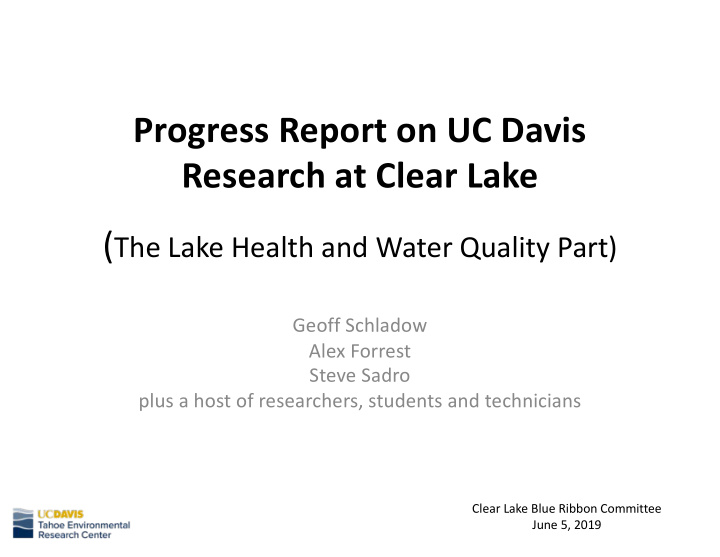



Progress Report on UC Davis Research at Clear Lake ( The Lake Health and Water Quality Part) Geoff Schladow Alex Forrest Steve Sadro plus a host of researchers, students and technicians Clear Lake Blue Ribbon Committee June 5, 2019
Clear Lake is the most complex lake in California UC Davis has been asked to conduct the science upon which to base a recovery plan Cyanobacteria bloom in Clear Lake (2016) Photo courtesy of Holly Harris
WELCOME TO CLEAR LAKE! EXTERNAL LOADS INTERNAL PROCESSES INTERNAL LOADS 1. All three need to be known 2. Hypothesis: internal lake processes => internal loads > external loads 3. Measurement program + stakeholder data 4. lake modeling => explore viable solutions 5. Lake modeling => quantify the impacts of watershed actions, climate change, ….
Fundam Fundamen ental al Q Ques uestion n - Wh What drives eut eutrophi phication n and and bl blue ue-gr green b blooms? External loading of nutrients Internal loading of nutrients Intense, but changing temperature stratification
Lake Monitoring Network • Stream monitoring sites • Lake moorings • Sediment traps • Meteorological sites
Stream Monitoring • In-situ optical turbidity sensors in primary tributaries to lake • Used to estimate sediment and nutrient loading
Lake Moorings
Orthophosphate in Clear Lake vs. Lake Tahoe (April 2019) 20 Micrograms-P per liter of lake water 15 IN SUMMER WE EXPECT THAT BOTTOM P 10 WILL INCREASE DRAMATICALLY 5 0 UA-08 UA-07 UA-06 UA-01 NR-02 OA-04 LA-03 L. TAHOE Micrograms-N per liter of lake water Nitrate + Nitrite in Clear Lake vs. Lake Tahoe (April 2019) 20 15 10 5 0 UA-08 UA-07 UA-06 UA-01 NR-02 OA-04 LA-03 L. TAHOE
Fine, Medium and Coarse Suspended Particles in Clear Lake vs. Lake Tahoe (April 2019) 10 Millions of particles per milliliter of lake water Fine = 0.5 – 2.8 microns Medium = 2.8 – 8.0 microns 8 Coarse = 8.0 – 16 microns 6 4 2 0 UA-08 UA-07 UA-06 UA-01 NR-02 OA-04 LA-03 L. TAHOE
Sediment Traps
New studies of lake sediments Sediment Traps • Quantify sedimentation rates • Analyze particle size distributions • Characterize carbon, nitrogen, and phosphorus content of sediments Sediment Incubations • Quantify P-release rates under different oxidative conditions • Characterize spatial and temporal variability in P-release • Model internal P-loading from sediments
Assessment of P-sampling methods Characterize vertical distribution of different P-fractions in sediments and advise Lake County regarding current sampling approach (other fractions not shown: loosely bound, Ca-bound, Fe-Al-bound, and residual)
Meteorological Sites
Variability in Wind Forcing N N 36% 36% 24% 24% 12% 12% 0% W E 0% W E S S N N 36% 36% 24% 24% 12% 12% 0% 0% W E W E N N N 36% 36% 36% S S 24% 24% 24% 12% 12% 12% Wind Speeds in mph W S 20 0% 0% W E 0% W E W E 15 W S < 20 10 W S < 15 5 W S < 10 0 W S < 5 S S S
3-D Hydrodynamic + WQ model
3-D Hydrodynamic + WQ model High resolution to understand Algal Blooms High resolution to understand Internal Loading
Advanced Instrumentation – to be deployed as the key questions get better defined
GAVIA AUV
SLOCUM GLIDER
SATELLITES, HELICOPTERS, DRONES
EDGETECH COMBINED BATHYMETRY BIOSONICS SCIENTIFIC and SIDE SCAN SONAR ECHOSOUNDER
CURRENT TRACKING IN THE OAKS ARM, 1997
BATHYMETRY – A MAJOR DEFICIENCY 879,384 points = 121,513 points/km 2 66,279 points = 413 points/km 2
GREATLY APPRECIATE THE DATA SHARING AND SPIRIT OF COLLABORATION WITH THE COUNTY, DWR, THE TRIBES, USGS, PAST CLEAR LAKE RESEARCHERS, PRIVATE CITIZENS…
THANK YOU
Recommend
More recommend